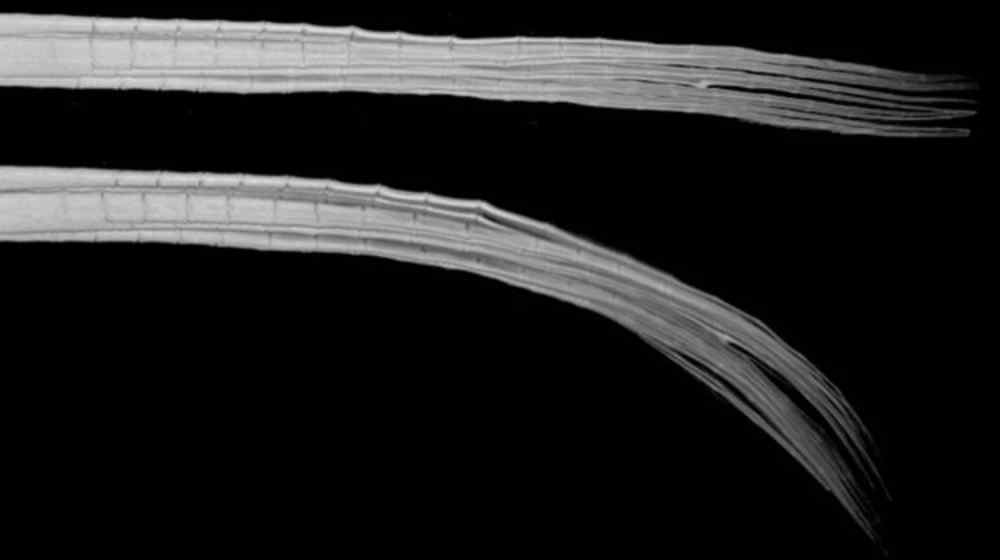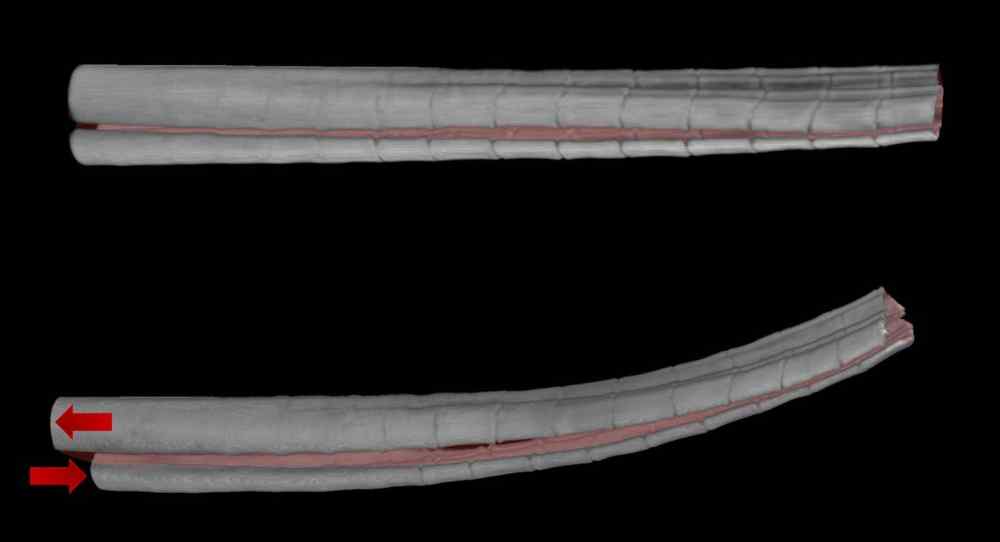A fish fin has the dual capabilities of being both strong and flexible. The tail-end of the fish morphs freely, but stiffens as it moves through water.
With a fin-like approach, could aircraft wings morph in a similar way?
Professor Francois Barthelat and his team at the University of Colorado Boulder want to explore the idea and incorporate the fin's sturdy, dexterous characteristics into robotic and aerospace designs. That means an airplane could fly with more fluidity, according to the lead researcher.
“Airplanes do this now, to some extent, when they drop their flaps,” said Barthelat, professor in the Paul M. Rady Department of Mechanical Engineering, in a recent news release .“But that’s in a rigid way. A wing made out of morphing materials, in contrast, could change its shape more radically and in a continuous manner, much like a bird.”
Through study and computer simulations, Barthelat and his team zeroed in on an important component of the fin: the protruding spines known as rays.
Each ray in a fin is made up of multiple segments of a hard material that stack on top of much softer collagen. Such layering leads to a perfect balance of bouncy and stiff characteristics.
"If you look at a fin, you'll see that it's made of many stiff 'rays,'" said Barthelat. "Each of those rays can be manipulated individually just like your fingers, but there are 20 or 30 of them in each fin."
Each of the rays, the team learned, has a layered structure — a bit like a bakery éclair, according to the UC Boulder professor.
Two layers of stiff and mineralized materials called hemitrichs surround an inner layer of spongy collagen. The"éclair," however, is segmented.
“Until recently, the function of those segments hadn’t been clear,” said Barthelat.
The segments, essentially, create tiny hinges along the ray. Compressing or pulling on the bony layers leads to high stiffness. Bending the layers makes them more compliant, and allows them to deform.
The engineers used 3D printers to try and create a kind of artificial fin. Some of the plastic parts had hinges built in; others did not. The team found that the segmented design provided better combinations of stiffness and morphing capabilities.

In a short Q&A with Tech Briefs below, Prof. Barthelat talks about some of the possibilities that he envisions with fin-like designs.
Tech Briefs: What are the valuable characteristics of an individual ray? How close can we get to producing the real thing via today’s manufacturing methods?
Prof. Francois Barthelat: Fins are excellent tools for underwater propulsion and maneuvering. The main structures of the fins are "rays" — or long bony spikes — that stiffen thin membranes of collagen. What makes the rays unique is that they are flexible enough to morph into a wide variety of shapes, yet they are stiff enough to push water without collapsing
We have recently shown that segmented hinges in the long thin bones of fish fins are critical to this remarkable combination of properties. This particular feature can be duplicated into synthetic materials using 3D printing, injection molding, machining etc., depending on the base materials and particular engineering application.
Other more intricate features of natural rays may be more difficult to implement in synthetic ray-like materials, but we have a few ideas on where to start.
Tech Briefs: Is the idea to incorporate 20-30 of these artificial rays into designs?
Prof. Barthelat: Yes, a potential design could be to duplicate the structure of the entire fish fin, with 20-30 synthetic rays that would stiffen a softer membrane or a thin plate. Each ray could be individually actuated to change shape, so that the overall thin structure could “morph” into a wide variety of 3D shapes and unusual curvatures.
Tech Briefs: What applications would most benefit from this type of design and integration?
Prof. Barthelat: This morphing structure could be very attractive for the fast maneuvering of surface vessels or submarines. In aerospace, this “bioinspired” material could be used as wings for airplanes or drones that could be actuated into radical shapes that would enable fast take-off, agile maneuvering and landing. We also have ideas to use individual ray-like structures that can change curvatures as a basis for robotics or morphing microsurgical tools.
Tech Briefs: What were some of the most interesting/surprising discoveries that computer simulations demonstrated to you?
Prof. Barthelat: We use computer simulations quite a bit, but only when we reach the limitations of what we can capture using pen-and-paper modeling and closed-form solutions. An exact, closed-form solution, even with approximations and assumptions, can be much more powerful and enlightening than a massive set of numerical data from a supercomputer. That being said, when we try to model systems with thousands of degrees of freedom and with nonlinear phenomena (like contact mechanics or buckling), we use numerical modeling.
To us the most interesting results are when our engineering models converge with natural evolution — that is, when our model predicts that a particular structure or mechanism is the best suited for an application, and to realize that nature has already been using that same exact structure or the same mechanisms for hundreds of millions of years. Our engineering models and optimization and natural evolution then converge to the same solution, which is what we like to see!
Tech Briefs: What inspired you to begin this research with fish fins?
Prof. Barthelat: In our research group we are constantly exploring new design concepts for engineering materials, and a lot of our inspiration came from natural materials. We have actually been working on fish mechanics for a long time, but focusing on the scales. Fish scales are some of the toughest materials in nature, and they inspired new flexible protective materials. Over these years lots of fish specimens from the fish market went through our lab, and by manipulating these specimens we got more and more interested in other structures in the fish, including the fins.
Tech Briefs: What’s next with this research?
Prof. Barthelat: We are currently developing proof-of-concept fin-inspired morphing materials that we intend to take all the way to engineering applications. Meanwhile there are many more structure features that are yet to be investigated in the rays of fins, and each has the potential to inspire new designs for engineering morphing materials. We are particularly interested in the complex arrangement of collagen fibers in individual rays. We suspect that at large deformations, highly nonlinear effects associated with these fibers improves mechanical performance even further.
What do you think? Share your questions and comments below.


